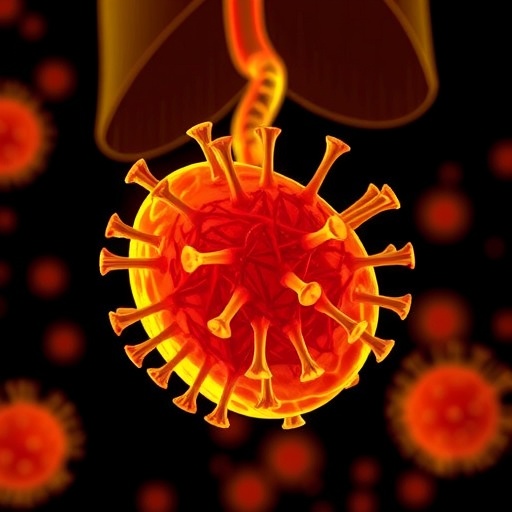In a groundbreaking study recently published in Nature Communications, researchers have delivered unprecedented insights into the presence of SARS-CoV-2 in fetal organs, shedding light on the mechanisms and implications of intraamniotic infection during pregnancy. The study meticulously investigates how the virus, responsible for the devastating COVID-19 pandemic, can traverse the placental barrier and infect fetal tissues, fundamentally advancing our understanding of vertical transmission pathways and fetal vulnerability.
The emergence of COVID-19 in late 2019 prompted an intense global scientific effort to unravel the virus’s multifaceted impacts on human health. However, much of the initial research was concentrated on adult populations, with relatively limited data on fetal infection and in utero transmission. Wu, Tang, Liu, and colleagues bridge this critical gap by elucidating viral presence directly within fetal organs, highlighting intraamniotic transmission as a potential route through which SARS-CoV-2 affects prenatal development.
Utilizing a combination of state-of-the-art molecular diagnostics, immunohistochemistry, and advanced imaging techniques, the research team examined fetal tissues from pregnancies complicated by maternal SARS-CoV-2 infection. The data reveal viral RNA and protein localization across multiple fetal organs, confirming active viral infiltration rather than mere passive viral passage. This distinction is paramount, as it suggests the virus replicates within fetal tissues, with possible detrimental consequences on organogenesis and fetal viability.
One of the pivotal findings of this study is the demonstration of viral RNA within the amniotic fluid, indicating that SARS-CoV-2 can infect the intraamniotic environment. The amniotic cavity, which cushions and nourishes the developing fetus, may thus serve as a reservoir facilitating viral transmission. This novel observation challenges previous assumptions that placental structures are impervious to SARS-CoV-2 and underscores the nuanced interactions within the maternal-fetal interface.
The placental barrier, composed of specialized trophoblastic cells, has traditionally been considered a formidable obstacle against most pathogens. However, the detailed analysis by Wu and colleagues reveals that SARS-CoV-2 can breach this barrier, possibly through direct viral entry or via infection of placental immune cells. The molecular pathways underlying this breach involve the expression of viral entry receptors such as ACE2 and TMPRSS2, which are variably expressed in placental tissues, potentially mediating susceptibility.
Importantly, the study delineates the distribution of the virus in different fetal organs, including the lungs, liver, kidney, and brain. Detection in the central nervous system is particularly alarming, as it raises concerns about potential neurodevelopmental sequelae following in utero exposure. The presence of viral particles and associated immune responses in these tissues could plausibly lead to inflammation, cellular damage, and altered organ function.
This research also integrates transcriptomic profiling to assess how fetal tissues respond to SARS-CoV-2 infection at the molecular level. The upregulation of interferon-stimulated genes and pro-inflammatory cytokines illustrates a robust fetal immune activation, which, while protective, may contribute to pathological inflammation. Understanding this delicate balance between antiviral defense and immunopathology is critical in predicting outcomes for infected fetuses.
The clinical ramifications of these findings are profound. Pregnancies complicated by maternal COVID-19 infection should be closely monitored for potential fetal involvement, especially in the context of preterm labor, fetal growth restriction, or unexplained fetal demise. The identification of intraamniotic infection necessitates reevaluation of current obstetric management guidelines, including considerations for timing and mode of delivery.
Furthermore, the study calls attention to the necessity of developing therapeutic strategies that can mitigate fetal infection while safeguarding maternal health. The potential role of antiviral agents, immunomodulators, or even vaccination during pregnancy emerges as a key area for future clinical trials, aiming to prevent vertical transmission and protect fetal development.
This work also prompts a reevaluation of neonatal care and follow-up protocols. Infants born to mothers with confirmed intraamniotic SARS-CoV-2 exposure may require specialized assessments for organ function and neurodevelopmental outcomes. Longitudinal studies will be essential to ascertain the full spectrum of consequences stemming from in utero viral exposure.
The robust methodological approach utilized in this study, combining histopathological examination with molecular and immunological techniques, sets a new standard for investigating fetal infections. It emphasizes the importance of interdisciplinary collaboration spanning virology, obstetrics, neonatology, and immunology to better address the challenges posed by emerging pathogens.
In sum, the discovery of SARS-CoV-2 within fetal organs via intraamniotic infection reshapes the scientific narrative around viral transmission during pregnancy. It underscores the vulnerabilities of the developing fetus and highlights the complex interplay between maternal infection, placental defense mechanisms, and fetal immune responses. This landmark study serves as both a warning and a guidepost for clinicians and researchers aiming to navigate the ongoing perinatal implications of the COVID-19 pandemic.
As the scientific community continues to grapple with emerging variants and ongoing waves of infection, understanding these vertical transmission dynamics will be pivotal for protecting the most vulnerable—unborn children. The work of Wu and collaborators not only deepens our biological comprehension but also ignites urgent conversations about healthcare policies and preventive measures in maternal-fetal medicine.
Ultimately, the presence of SARS-CoV-2 in fetal organs reported by this study demands heightened vigilance and innovation in both clinical management and research. Efforts must coalesce around safeguarding the health of pregnant individuals and their offspring, ensuring that scientific advances translate into tangible protections against the unseen perils of intrauterine viral infections.
Subject of Research: Presence of SARS-CoV-2 in fetal organs induced by intraamniotic infection.
Article Title: Presence of SARS-CoV-2 in fetal organs via intraamniotic infection.
Article References:
Wu, S., Tang, L., Liu, Z. et al. Presence of SARS-CoV-2 in fetal organs via intraamniotic infection. Nat Commun 16, 10261 (2025). https://doi.org/10.1038/s41467-025-65131-1
Image Credits: AI Generated
DOI: https://doi.org/10.1038/s41467-025-65131-1




